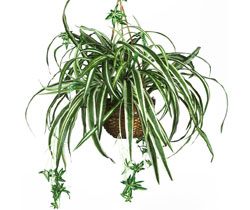
Bamboo Palm (Chamaedorea seifrizii) or “Reed Palm”
Main Points:
Easy to care for, effective at removing indoor air toxins (especially benzene, trichloroethylene and formaldehyde), and more resistant to insect infestation than areca palms. Can reach a height of about 6 feet.
In addition to its high air-cleansing rating, this plant boasts a high transpiration rating (pumps moisture into the air).
Care:
Semi-sun.
Keep this plant pruned. When leaves start to turn yellow or brown and wilt, use pruning shears to remove these leaves at the base.
Signs of over-watering: If you are over-watering, the leaf tips begin to turn yellow and fall off, and the new growth will look pale. Stem rot is another symptom of over-watering.
Signs of under-watering: the tips will turn brown if the soil is not maintained uniformly moist.
The Bamboo Palm is a shade plant, so any lighted area (natural or artificial) will allow this plant to flourish. Maintain your palm’s fullness by turning the container 1/4 turn every week to allow light to penetrate evenly.
Be vigiliant for spider mites, however, as they prey on plants grown in the too-dry conditions common in homes and offices.
Most growers find success using a granular, time-release fertilizer for the palm tree. Seifrizii is sensitive to soluble salts, so remove the fertilizer from the top of the pot and leach the soil thoroughly with water. Allow the plant to completely drain. When the soil has dried down about one third or half way down from the top, water the plant from the top, thoroughly.
Water generously in spring and summer, keeping the soil moist, but do not let this palm sit in standing water (drain the bottom plate of excess water), as excess water will damage the roots. Keep the root ball moist in the winter. Wash the leaves periodically with soap and water to prevent spider mites.
